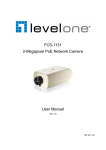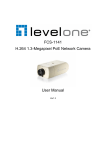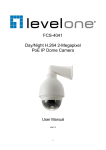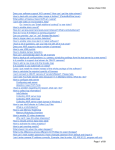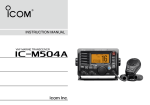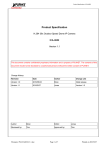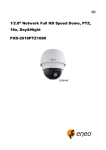Download H.264 36x Outdoor Speed Dome IP Camera User`s manual
Transcript
H.264 36x Outdoor Speed Dome IP Camera ICA-H652 User’s manual Version 1.0.0 -1- Copyright Copyright (C) 2010 PLANET Technology Corp. All rights reserved. The products and programs described in this User’s Manual are licensed products of PLANET Technology, This User’s Manual contains proprietary information protected by copyright, and this User’s Manual and all accompanying hardware, software, and documentation are copyrighted. No part of this User’s Manual may be copied, photocopied, reproduced, translated, or reduced to any electronic medium or machine-readable form by any means by electronic or mechanical. Including photocopying, recording, or information storage and retrieval systems, for any purpose other than the purchaser's personal use, and without the prior express written permission of PLANET Technology. Disclaimer PLANET Technology does not warrant that the hardware will work properly in all environments and applications, and makes no warranty and representation, either implied or expressed, with respect to the quality, performance, merchantability, or fitness for a particular purpose. PLANET has made every effort to ensure that this User’s Manual is accurate; PLANET disclaims liability for any inaccuracies or omissions that may have occurred. Information in this User’s Manual is subject to change without notice and does not represent a commitment on the part of PLANET. PLANET assumes no responsibility for any inaccuracies that may be contained in this User’s Manual. PLANET makes no commitment to update or keep current the information in this User’s Manual, and reserves the right to make improvements to this User’s Manual and/or to the products described in this User’s Manual, at any time without notice. If you find information in this manual that is incorrect, misleading, or incomplete, we would appreciate your comments and suggestions. CE mark Warning The is a class A device, In a domestic environment, this product may cause radio interference, in which case the user may be required to take adequate measures. WEEE Warning To avoid the potential effects on the environment and human health as a result of the presence of hazardous substances in electrical and electronic equipment, end users of electrical and electronic equipment should understand the meaning of the crossed-out wheeled bin symbol. Do not dispose of WEEE as unsorted municipal waste and have to collect such WEEE separately. Trademarks The PLANET logo is a trademark of PLANET Technology. This documentation may refer to numerous hardware and software products by their trade names. In most, if not all cases, their respective companies claim these designations as trademarks or registered trademarks. -2- Revision User’s Manual for PLANET H.264 36x Outdoor Speed Dome IP Camera Model: ICA-H652 Rev: 1.0.0 (2010, Augest) Part No. EM-ICAH652_v1 -3- TABLE OF CONTENTS Chapter 1 Introduction ............................................................................................................ 6 Overview....................................................................................................................................................... 6 Package Content .......................................................................................................................................... 7 Physical Details ............................................................................................................................................ 7 Camera Substance ................................................................................................................................ 7 Switch Identification ............................................................................................................................ 8 Chapter 2 Camera Setup and Cable Connections............................................................... 10 Physical Installation Requirement............................................................................................................ 10 2.1 System Requirements .......................................................................................................................... 10 2.2 Verify the Contents Inside Package Box ............................................................................................ 10 2.3 Physical Installation............................................................................................................................. 11 2.4 Dome Camera Setups .......................................................................................................................... 18 2.4.1 Switch/Connector Definition........................................................................................... 18 2.4.2 Communication Switch Setting....................................................................................... 18 2.5 Cables and Connections ...................................................................................................................... 19 2.5.1 Cable Requirements ........................................................................................................ 19 2.5.2 22-Pin Data Cable ........................................................................................................... 19 2.5.3 22-Pin Connector Definition ........................................................................................... 20 Chapter 3 Accessing Camera................................................................................................. 21 3.1 Device Search Software Setup............................................................................................................. 21 3.2 Device Search ....................................................................................................................................... 21 3.3 Example of Changing IP Camera’s Network Property .................................................................... 23 3.4 Installing DC Viewer Software Online ............................................................................................... 24 3.5 Administrator / User Privileges........................................................................................................... 26 Chapter 4 Configuration & Operation................................................................................. 27 4.1 Browser-based Viewer Introduction................................................................................................... 27 4.2 Home Page ......................................................................................................................................... 28 4.3 System Related Settings.................................................................................................................... 31 4.3.1 Host Name and System Time Setting.............................................................................. 32 4.3.2 Security ........................................................................................................................... 32 4.3.3 Network........................................................................................................................... 34 4.3.4 DDNS.............................................................................................................................. 37 4.3.5 Mail ................................................................................................................................. 38 4.3.6 FTP.................................................................................................................................. 38 4.3.7 Application (Alarm Settings) .......................................................................................... 39 4.3.8 Motion Detection............................................................................................................. 45 4.3.9 Snapshot .......................................................................................................................... 48 -4- 4.3.10 View Log File.................................................................................................................. 49 4.3.11 View User Information.................................................................................................... 49 4.3.12 View Parameters.............................................................................................................. 51 4.3.13 Factory Default................................................................................................................ 51 4.3.14 Software Version ............................................................................................................. 52 4.3.15 Software Upgrade............................................................................................................ 52 4.4 Video and Audio Streaming Settings .................................................................................................. 54 4.4.1 Video Resolution and Deinterlacing Function................................................................. 54 4.4.2 Video Compression ......................................................................................................... 55 4.4.3 Video OCX Protocol ....................................................................................................... 56 4.4.4 Video Frame Skip............................................................................................................ 57 4.4.5 Audio Mode and Bit Rate Settings.................................................................................. 58 4.5 PTZ Settings ......................................................................................................................................... 59 4.6 4.5.1 Preset ............................................................................................................................... 59 4.5.2 Cruise .............................................................................................................................. 59 4.5.3 Auto Pan.......................................................................................................................... 60 4.5.4 Sequence ......................................................................................................................... 61 4.5.5 Home ............................................................................................................................... 63 4.5.6 Tilt Angle......................................................................................................................... 64 4.5.7 Privacy Mask................................................................................................................... 64 4.5.8 Camera - Exposure .......................................................................................................... 66 4.5.9 Camera - WB................................................................................................................... 66 4.5.10 Camera - Miscellaneous Setups Menu 1 ......................................................................... 67 4.5.11 Camera - Miscellaneous Setups Menu 2 ......................................................................... 69 4.5.12 Camera - Default ............................................................................................................. 70 Logout ................................................................................................................................................ 71 Appendix A: IP Camera Specifications .................................................................................................... 72 Appendix B: Internet Security Settings ................................................................................................... 74 Appendix C: DC Viewer Download Procedure ....................................................................................... 77 Appendix D: Frequently Asked Questions............................................................................................... 79 -5- Chapter 1 Introduction 1 Overview The PLANET ICA-H652 is the outdoor speed dome Internet camera offering the next generation video compression – H.264. It is a perfect and effective surveillance solution for the bandwidth limited networks. The ICA-H652 features a 36x12 zooming (36x optical zoom, 12x digital zoom) with auto focus and auto iris. It offers fast, accurate and continuous 360 panning operations. The unparalleled surveillance functions of the ICA-H652 including 256 camera presets, 8 camera cruise configurations, and the motion detection function make it able to satisfy the demanding surveillance and remote monitoring applications. The ICA-H652 provides Multi-profile function which can generate H.264 and M-JPEG video streaming simultaneously. Moreover, the resolution can be different from one user to another. This state-of-the-art design is considerable to fit in various network environments like traffic centers, shopping malls, railway stations, warehouses, airports, and production facilities. The ICA-H652 supports Store-to-NAS function to work alone and save the video file to a NAS directly, which can save the PC resource and keep monitoring the environment with motion detection at 7/24. It takes surveillance using 2-Way audio so that the administrator can speak to anyone at ICA-H652 remote site with a speaker connected. The ICA-H652 can also be installed in most of bad outdoor environment and keep working properly with the IP-66 protecting cover. Product Features • Multi-profile encoder supports H.264 and M-JPEG video compression simultaneously • D1 / CIF Real-time resolutions (30fps) • 360 degree continuous PAN, Tilt (0 ~ 180 degree) and 36x12 zooming (36X optical, 12X digital) adjustment • High resolution quality pictures for day and night surveillance • Built-in IR Cut Filter (ICR) • 3D de-interlaced video image • Wide Dynamic Range (WDR) • 2D/3D Noise Reduction • Store-to-NAS function to save video files without operating software • 3GPP for 3G mobile remote applications, iPhone viewer support -6- • Supporting TCP/IP networking, SMTP e-mail and HTTP public network standards, the ICA-H652 can be applied and utilized to a mixed IP network environment • Easy configuration: network administrators can configure and manage the ICA-H652 via Windows-based utility or web interface • DDNS and FTP uploading supports more alternatives in surveillance network • Motion Detection: the motion detection feature can monitor any suspicious movement in specific area • IP-66 outdoor classification with heater and fan for rigorous environment Package Content The contents of your product should contain the following items: Dome Camera with Outdoor Mount Kit Compact Pendent Mount Kit Data Cable Waterproof Rubber Dome Cover M3/M5 Standard Screw M3/M5 Security Screw Lubricant Security Tool Bracket screws kit Quick installation guide User’s manual CD Power Adapter Physical Details Camera Substance -7- 1. Outdoor Mount 2. Compact Pendent Mount 3. Dome Cover Switch Identification Item F Description A None B Communication Switch (Reserved) C RJ45 Connector D Data Cable 22-Pin Connector E None F1 Reboot Button -8- F2 G Factory Reset Button ISP Connector (for FW upgrade) DO NOT change the Speed Dome IP Camera’s Communication Switch factory default Note settings. -9- Chapter 2 Camera Setup and Cable Connections 2 Physical Installation Requirement Before installing or connecting the dome camera, please refer to this section and complete preparations for dome setups and various switch settings. 2.1 System Requirements To perform the IP Camera via web browser, please ensure your PC is in good network connection, and meet system requirements as described below for appropriate setup and well view quality. Items Personal Computer System Requirement 1. Intel○R Pentium○R M, 2.16 GHz or Intel○R CoreTM2 Duo, 2.0 GHz 2. 2 GB RAM or more Operating System Windows Vista or Windows XP Web Browser Microsoft Internet Explorer 6.0 or later Network Card 10Base-T (10 Mbps) or 100Base-TX (100 Mbps) operation Viewer ActiveX control plug-in for Microsoft IE 2.2 Verify the Contents Inside Package Box The package should contain the below items. If any item is missing or damaged, please contact the seller immediately. Dome Camera with Outdoor Compact Pendent Mount Data Cable Dome Cover Bracket screws kit Mount Kit Waterproof Rubber - 10 - Security Tool Lubricant M3/M5 Standard Screw M3/M5 Security Screw Quick Installation Guide CD-ROM AC Power Adapter 2.3 Physical Installation 1. During the installation, please take care and avoid crash. That may cause the device damage or cause injury of the installer. Caution 2. Please make sure the hardware had been located on the wall properly. If the hardware drops down, it is possible make someone injury or hurt. Please check the hardware again after the installation. 3. Please according to the practical local power voltage to adjust the power switch. The wrong input voltage may cause the device damage. STEP 1. Unpack the Dome Camera’s package and take out the Dome Camera unit. - 11 - STEP 2. Rotate the Outdoor Mount Kit, and take it off from the camera body. STEP 3. Attach the dome cover to the camera body. Before doing that, apply some lubricant on the cover’s water-proof rubber to make the installation process smoother. The tiny protrusion on the dome cover must align with one of the four holes on the dome Note body. STEP 4. Gently pressure the dome cover downward with two hands on the side of it. DO NOT press the cover, as shown in the figure; this might cause damage to the camera body. - 12 - STEP 5. Use the M3 screw to screw the dome cover and camera body together. STEP 6. Make a cable entry hole on the wall to recess the cables. Otherwise, users could push up the Cable Entry Board on the Compact Pendent Mount’s Mounting Plate to place the cables, as shown in the photo below. STEP 7. Fix the Compact Pendent Mount on the wall with proper screws and screw anchors. - 13 - The screws and screw anchors don’t attach in package. Note STEP 8. Attach the Waterproof Rubber to the Outdoor Wall Mount. STEP 9. Pass the network and data cables through the Compact Pendent Mount with the Data Cable’s 22-pin cable coming out of the outlet. 1. The network cable doesn’t attach in package 2. Please block the cable entry hole with the supplied sponge to avoid insects entering the Note Pendent Mount. The sponge can be placed in two ways as shown in the illustrations below. - 14 - STEP 10. Thread the cables through the Outdoor Mount Kit and join the Outdoor Mount Kit to the Compact Pendent Mount with the supplied screws and washers. Then adjust the Waterproof Rubber to the joint. STEP 11. Use the safety hook hanging the camera, and connect the cables to the Dome Camera. - 15 - STEP 12. Join the Dome Camera to the Outdoor Mount Kit with the supplied M5 screw and washers. STEP 13. Connecting the AC power adapter with Power Input connector of data cable. Then according to the practical local power voltage to adjust the power switch, and connect the power cord with adapter and power outlet. - 16 - Use only the power adapter shipped with the unit to ensure correct functionality Note STEP 14. Connecting the network cable with switch. STEP 15. Set your computer’s IP address to 192.168.0.x, where x is a number between 1 to 253 (except 20 where is being used for the camera by default). If you don’t know how to do this, please ask your network administrator. STEP 16. Use web browser (Internet Explorer 6.0 or above) to connect to 192.168.0.20 (type this address in the address bar of web browser). You’ll be prompted to input user name and password: admin / null (without password). - 17 - 2.4 Dome Camera Setups Before connecting the IP Camera to other devices of IP Surveillance system, please complete the IP Camera’s ID and communication switch settings. These switches are located on the bottom of the IP Camera. 2.4.1 Switch/Connector Definition Item Description A None B Communication Switch (Reserved) C RJ45 Connector D Data Cable 22-Pin Connector E None F G F1 Reboot Button F2 Factory Reset Button ISP Connector (for FW upgrade) DO NOT change the Speed Dome IP Camera’s Communication Switch factory default Note settings. 2.4.2 Communication Switch Setting - 18 - Communication Switch SW 1 Reserved SW 2 SW 3 Termination SW 4 Line Lock SW 5 Factory Default Reset SW 6 Reserved Please do not change the default setting without qualified specialist or supplier’s notice. As for the SW 3 and SW 4, they are used for termination and Line Lock adjustment respectively. The SW 5 is mainly used when users want t o restore the camera to the factory default status; moreover, once firmware upgrade is carried out, users also need to reset the SW 5 afterward. 2.5 Cables and Connections The Dome Camera is supplied with one integrated 22-pin Data Cable for connecting with the power, video, and audio input & audio output cables. Please read the following sections thoroughly before making connections. 2.5.1 Cable Requirements For operation, the Integrated Speed Dome IP Cameras require video and power cables as described below: • The video cable sends video signals to a remote viewing site. Using a coaxial cable to send video signals is recommended. • Power supply: DC 12V/AC 24V output voltage Ensure power supply meets the Dome Camera’s power requirement, or product impairment will occur. If any mistake happens, please contact with a qualified Note 2.5.2 maintenance engineer. 22-Pin Data Cable The Speed Dome IP Camera’s Data Cables are illustrated respectively as shown below. - 19 - 2.5.3 22-Pin Connector Definition With the 22-pin connector, installers can simply connect the power and video cables to the IP Camera at once. Particularly, the alarm pins are serviceable for connecting alarm input and output devices, such as alarm sensors, sirens or flashing lights with the surveillance system. The Speed Dome IP Cameras’ 22-pin connector definition will also be specified as follows. Pin Definition Cable Pin 1 AC 24-1/DC (+) 20AWG 12 ALM-1 2 ALM NC 13 ALM-3 3 AC 24-2/DC (-) 14 ALM-2 4 ALM NO 15 ALM-4 5 FG 16 Reserved 6 ALM COM 17 Reserved 7 Audio in 18 Reserved 8 Audio out 19 Reserved 9 Audio GND 20 ALM GND 10 Audio GND 21 VGND 11 ISOG 22 Video 20AWG 20AWG 24AWG - 20 - Definition Cable 24AWG Chapter 3 Accessing Camera 3 For initial access to the IP Camera, users can search the camera through the installer program: DeviceSearch.exe, which can be found in “DeviceSearch” folder in the supplied CD. 3.1 Device Search Software Setup Step 1: Double click on the program Planet Device Search.exe (see the icon below); its window will appear as shown below. Then click the “Device Search” button. Step 2: The security alert window will pop up. Click “Run” to continue. 3.2 Device Search Step 3: Click “Device Search” again, and all the finding IP devices will be listed in the page, as shown - 21 - in the figure below. The IP Camera’s default IP address is: 192.168.0.20. Step 4: Double click or right click and select “Browse” to access the camera directly via web browser. Step 5: Then the prompt window of request for entering default username and password (as shown below) will appear for logging in to the IP Camera. The default login ID and password for the Administrator are: Login ID Password admin null (without password) NOTE: ID and password are case sensitive. - 22 - NOTE: It is strongly advised that administrator’s password be altered for the security concerns. Refer to section 4.3.2 Security for further details. Additionally, users can change the IP Camera’s network property, either DHCP or Static IP, directly in the device finding list. Refer to the following section for changing the IP Camera’s network property. 3.3 Example of Changing IP Camera’s Network Property Users can directly change an IP Camera’s network property, ex. from static IP to DHCP, in the finding device list. The way to change the IP Camera’s network property is specified below: Step 1: In the finding device list, click on the IP Camera that you would like to change its network property. On the selected item, right click and select “Network Setup.” Meanwhile, record the IP Camera’s MAC address, for future identification. Step 2: The “Network Setup” page will come out. Select “DHCP,” and press “Apply” button down the page. - 23 - Step 3: Click “OK” on the Note of setting change. Wait for one minute to re-search the IP Camera. Step 4: Click the “Device Search” button to search all the devices. Then select the IP Camera with the correct MAC address. Double click on the IP Camera, and the login window will come out. Step 5: Enter User name and Password to access the IP Camera. 3.4 Installing DC Viewer Software Online For the initial access to the IP Camera, a client program, DC Viewer, will be automatically installed to your PC when connecting to the IP Camera. - 24 - If the Web browser doesn’t allow DC Viewer installation, please check the Internet security settings or ActiveX controls and plug-ins settings (see Appendix B: Internet Security Settings) to continue the process. The Information Bar (just below the URL bar) may come out and ask for permission to install the ActiveX Control for displaying video in browser (see the figure below). Right click on the Information Bar and select “Install ActiveX Control…” to allow the installation. Then the security warning window will pop up. Click “Install” to carry on software installation. Click “Finish” to close the DC Viewer window when download is finished. Once login to the IP Camera, users will see the Home page as shown below: - 25 - NOTE: The “talk” button below the screen only displays in ICA-HM126 Series IP Camera. 3.5 Administrator / User Privileges “Administrator” represents the person who can configure the IP Camera and authorize user’s access to the camera; “User” refers to whoever has access to the camera with limited authority, i.e. entering Home and Camera setting pages. - 26 - Chapter 4 Configuration & Operation 4 The IP Camera is provided with a user-friendly browser-based configuration interface, and a free bundled CMS (Central Management System) for record and playback video. In this chapter, information about main page introduction, system related settings and camera settings will be described in detail. 4.1 Browser-based Viewer Introduction The figure below shows the Home page of the IP Camera’s Viewer Window. Viewer Window Setting Tab Time Display Live Video Video Format Selection Snapshot Button Talk Button Zoom / Focus Tuning Display Mode Video Compression info There are five tabs: Home, System, Streaming, PTZ and Logout on the top of the viewer window. Home Users can monitor live video of the targeted area. - 27 - System setting The administrator can set host name, system time, root password, network related settings, etc. Further details will be interpreted in section 4.3 System Related Settings. Streaming setting The administrator can modify video resolution and rotate type and select audio compression mode in this page. PTZ setting Users can adjust various camera parameters such as Exposure, White Balance, Backlight Compensation, etc., and program functions including Preset, Cruise, Auto Pan, Sequence, etc. Logout Click on the tab to re-login the IP Camera with another username and password. 4.2 Home Page On the Home Page, users can view live video and operate Pan/Tilt/Zoom (PTZ) function. Additionally, users can select a video display format and image display size and adjust zoom ratio/focus length through related function buttons. All of these functions are described as follows: - 28 - Screen Size Adjustment Image display size can be adjusted to x1/2 and full screen via the related buttons. To switch between the normal view mode and full screen view mode, users can also move the cursor to the live / video pane and right-clink; then the tab will display over the video pane as shown in the figure below. Left click on either the “Normal View” or “Full screen” tab for setting image display mode. Pan/Tilt Control Users can implement pan/tilt control by first moving the cursor to the live video pane; then left click and drag the pointer in any direction. Optical/Digital Zoom Control In Normal View display mode, users can implement zoom in/out by first moving the cursor to the live video pane and then rotating the mouse wheel. As in Full Screen mode, users can directly rotate the mouse wheel to zoom in/out on the image. Digital zoom is only available when the function is activated and which is set in “Camera-Misc1” page under the “PTZ” tab; see section 4.5.10 Camera Miscellaneous Setups Menu 1 for details. When the camera reaches the limit of its optical range, it will automatically switch to digital zoom. Talk Talk function allows the local site talks to the remote site. Please refer to section 4.3.2 Security: Add user > Talk/Listen for further details. This function is only open to “User” who has been granted this privilege by the Administrator. Snapshot Press the button, and the JPEG snapshots will automatically be saved in the appointed place. The default place of saving snapshots is: C:\. To change the storage location, please refer to section 4.3.9 Snapshot for further details. Zoom Adjustment Click on the buttons wide/tele to control zoom in/out. Move the cursor closely onto the zoom adjustment bar and click on the desired position to change the room ratio. Focus Adjustment - 29 - z Auto Focus (Continuous AF): Click on the “auto” button to enable AF mode. In this mode, the camera will keep in focus automatically and continuously regardless of zoom changes or any view changes. The Focus status will also be displayed above the live video pane as shown below. z Manual Focus: Click on the “manual” button, and users can adjust focus manually via “near” and “far” buttons. The status will also be displayed above the screen as shown below. - 30 - 4.3 System Related Settings The figure below shows all categories under the “System” tab. Each category in the left column will be explained in the following sections. NOTE: The “System” configuration page is only accessible by the Administrator. - 31 - 4.3.1 Host Name and System Time Setting Press the first category: <System> in the left column; the page is shown as below. Host Name The name is for camera identification. If Motion Detection function is enabled and is set to send alarm message by Mail/FTP, the host name entered here will display in the alarm message. Time Zone Select the time zone you are in from the drop-down menu. Sync with Computer Time Select the item, and video date and time display will synchronize with the PC’s. Manual The Administrator can set video date, time and day manually. Entry format should be identical with that shown next to the enter fields. Sync with NTP server Network Time Protocol (NTP) is an alternate way to synchronize your camera’s clock with a NTP server. Please specify the server you wish to synchronize in the enter field. Then select an update interval from the drop-down menu. For further information about NTP, please see the web site: www.ntp.org. 4.3.2 Security Click the category: <Security>, and the page is shown as the figure below. - 32 - Root password Change the administrator’s password by inputting the new password in both text boxes. The input characters/numbers will be displayed as dots for security purposes. After clicking <Save>, the web browser will ask the Administrator for the new password for access. The maximum length of the password is 14 digits. NOTE: The following characters are valid: A-Z, a-z, 0-9, !#$%&’-.@^_~. Add user Type the new user's name and password and click <Add> to add the new user. Both user name and password can be up to 16 characters. The new user will be displayed in the user name list. There is a maximum of twenty user accounts. Each user can be assigned the privileges of “Camera control” and/or “Listen”. • I/O access This item supports fundamental functions that enable users to view video when accessing to the camera. • Camera control This item allows the appointed User to change camera parameters on the Camera Setting page. • Talk / Listen Talk and Listen functions allow the appointed user in the local site (PC site) communicating with, for instance, the administrator in the remote site. - 33 - Manage User Delete user To delete a user, pull down the user list, and select the user name you wish to delete. Then click <Delete> to remove it. Edit user Pull down the user list and select a user name. Click <Edit> to edit the user’s password and privilege. NOTE: It is required to enter the User password as well as select the function open to the user. When finished, click <Save> to modify the account authority. 4.3.3 Network Click <Network> in the left column, and the page will display as shown below. - 34 - Users can choose to use fixed IP address or dynamic (DHCP) IP address. The following is descriptions for the two ways of setting IP address. Get IP address automatically (DHCP) The camera’s default setting is “Use fixed IP address”. Please refer to the previous section Chapter 3. Accessing Camera for logging in with the default IP address. If select “Get IP address automatically”, after the IP Camera restarts, users can search it through the installer program: DeviceSearch.exe, which can be found in “DeviceSearch” folder in the supplied CD. NOTE: Please make the record of the IP Camera’s MAC address, which can be found in the label of the camera, for identification in the future. Use fixed IP address To setup static IP address, select “Use fixed IP address” and move the cursor to the IP address blank (as indicated below) and insert the new IP address, ex. 192.168.0.250; then go to the Default gateway (explained latter) blank and change the setting, ex. 192.168.0.250. Press “Save” to confirm the new setting. - 35 - When using static IP address to login to the IP Camera, users can access it either through “DeviceSearch” software (see Chapter 3. Accessing Camera) or input the IP address in the URL bar and press “Enter”. General • IP address This is necessary for network identification. • Subnet mask It is used to determine if the destination is in the same subnet. The default value is “255.255.255.0”. • Default gateway This is the gateway used to forward frames to destinations in different subnet. Invalid gateway setting will fail the transmission to destinations in different subnet. • Primary DNS Primary DNS is the primary domain name server that translates hostnames into IP addresses. • Secondary DNS - 36 - Secondary DNS is a secondary domain name server that backups the primary DNS. • Web Server port The default web server port is 80. Once the port is changed, the user must be notified the change for the connection to be successful. For instance, when the Administrator changes the HTTP port of the IP Camera whose IP address is 192.168.0.100 from 80 to 8080, the user must type in the web browser “http://192.168.0.100:8080” instead of “http://192.168.0.100”. Advanced • RTSP port RTSP port could be set from 1 to 65535. (Normal Setting Port: 554, 1024 ~65535) • MJPEG over HTTP port The default setting of HTTP Port is 8008; setting range: 1024 ~65535. NOTE: Be aware to choose the different port from the one set for the web server port. 4.3.4 DDNS Dynamic Domain Name System (DDNS) allows a host name to be constantly synchronized with a dynamic IP address. In other words, it allows those using a dynamic IP address to be associated to a static domain name so others can connect to it by name. Enable DDNS Check the item to enable DDNS. Provider - 37 - Select one DDNS host from the provider list. Host name Enter the registered domain name in the field. Username/E-mail Enter the username or e-mail required by the DDNS provider for authentication. Password/Key Enter the password or key required by the DDNS provider for authentication. 4.3.5 Mail The Administrator can send an e-mail via Simple Mail Transfer Protocol (SMTP) when motion is detected. SMTP is a protocol for sending e-mail messages between servers. SMTP is a relatively simple, text-based protocol, where one or more recipients of a message are specified and the message text is transferred. The configuration page is shown as follows: Two sets of SMTP can be configured. Each set includes SMTP Server, Account Name, Password and E-mail Address settings. For SMTP server, contact your network service provider for more specific information. 4.3.6 FTP The Administrator can set as sending alarm message to a specific File Transfer Protocol (FTP) site when motion is detected. Users can assign alarm message to up to two FTP sites. The FTP setting page is shown below. Enter the FTP details, which include server, server port, user name, password and remote folder, in the fields. Press “Save” when finished. - 38 - 4.3.7 Application (Alarm Settings) The Speed Dome IP Camera supports 5 alarm inputs and 1 alarm output. Please make sure the alarm connections are properly wired before starting to configure alarm related settings on this “Application” page. Please refer to the pin definition table below for alarm system wiring. Pin Definition Cable Pin 1 AC 24-1/DC (+) 20AWG 12 ALM-1 2 ALM NC 13 ALM-3 3 AC 24-2/DC (-) 14 ALM-2 4 ALM NO 15 ALM-4 5 FG 16 Reserved 6 ALM COM 17 Reserved 7 Audio in 18 Reserved 8 Audio out 19 Reserved 9 Audio GND 20 ALM GND 10 Audio GND 21 VGND 11 ISOG 22 Video 20AWG 20AWG 24AWG - 39 - Definition Cable 24AWG Alarm Pin Selection Select an alarm pin which is to be configured from the “Alarm Pin Selection” field. Then press the button “Edit” below the field to carry on alarm programming. Alarm Status Settings The specific alarm pin’s property can be programmed in this section as shown below. - 40 - Alarm Switch The Administrator can enable or disable the alarm function. Alarm Type Select an alarm type, “Normal close” or “Normal open,” that corresponds with the alarm application. Alarm Output Define alarm output signal “high” or “low” as the normal alarm output status according to the current alarm application. Action (Multi-option) The Administrator can specify alarm actions that will take when the alarm is triggered. All options are listed as follows: • Enable Alarm Output Select the item to enable alarm relay output. • Send Alarm Message by FTP/E-Mail The Administrator can select whether to send an alarm message by FTP and/or E-Mail when an alarm is triggered. • Upload Image by FTP Select this item, and the Administrator can assign a FTP site and configure various parameters as shown in the figure below. When the alarm is triggered, event images will be uploaded to the appointed FTP site. - 41 - • Upload Image by E-Mail Select this item, and the Administrator can assign an e-mail address and configure various parameters as shown in the figure below. When the alarm is triggered, event images will be sent to the appointed e-mail address. - 42 - NOTE: Make sure SMTP or FTP configuration has been completed. See section 4.3.5 Mail and 4.3.6 FTP for further details. • Function Assign a camera function: Preset, Sequence, Autopan or Cruise, and specify a Preset Point/Sequence Line/Autopan Path/Cruise Line for the camera to perform at an alarm occurrence. NOTE: Please refer to the sections through 4.5.1 Preset Programming to 4.5.4 Sequence Line Programming for details of Preset Point / Sequence Line / Autopan Path / Cruise Line setups. If the selected function is “Preset,” it is required to enter its dwell time (1 ~ 256 sec.) in the corresponding field as shown below. When the alarm is triggered, the camera will go to the selected Preset Point and stay there for a user-defined period of time. As for other function modes, the camera will keep executing the specified function; to stop the performance, simply change the camera’s status. - 43 - NOTE: The dwell time is only adjustable when selecting Preset as the alarm action. When the dwell time is up, the Speed Dome IP Camera will go back to its trigger position and recheck alarm pin status. File Name Enter a file name in the blank, ex. image.jpg. The uploaded image’s file name format can be set in this section. Please select the one that meets your requirements. • Add date/time suffix File name: imageYYMMDD_HHNNSS_XX.jpg Y: Year, M: Month, D: Day H: Hour, N: Minute, S: Second X: Sequence Number • Add sequence number suffix (no maximum value) File name: imageXXXXXXX.jpg X: Sequence Number • Add sequence number suffix (limited value) File Name: imageXX.jpg X: Sequence Number - 44 - The file name suffix will end at the number being set. For example, if the setting is up to “10,” the file name will start from 00, end at 10, and then start all over again. • Overwrite The original image in the FTP site will be overwritten by the new uploaded file with a static filename. Save After complete all the settings mentions above, please click on the Save button to save all the settings in this page. 4.3.8 Motion Detection Motion Detection function allows detecting suspicious motion and triggering alarms when motion volume in the detected area reaches/exceeds the determined sensitivity threshold value. In the Motion Detection setting page, there is a frame (Motion Detection Window) displayed on the Live View Pane. The Motion Detection Window is for defining the motion detection area. To change the size of the Motion Detection Window, move the mouse cursor to the edge of the frame and draw it outward/inward. Moving the mouse to the center of the frame can shift the frame to the intended location. Up 10 Motion Detection Windows can be set. Press the “add” button under the Live View Pane to add a Motion Detection Window. To cancel a Motion Detection Window, move the mouse cursor to the selected Window, and click on the “delete” button. - 45 - If Motion Detection function is activated, the pop-off window (Motion) with indication of motion will be shown. When motion is detected, the signals will be displayed on the Motion window as shown below. Detailed settings of Motion Detection are described as follows: Motion Detection You will be able to turn on/off Motion Detection in System section. Default setting is Off. Motion Detection Setting Users could adjust various parameters of Motion Detection in this section. • Sampling pixel interval [1-100]: The default value is 10, which means system will take one sampling pixel for every 10 pixel. • Detection level [1-100]: The default level is 10. The item is to set detection level for each sampling pixel; the smaller the value, the more sensitive it is. • Sensitivity level [1-100]: The default level is 80, which means if 20% or more sampling pixels are detected differently, system will detect motion. The bigger the value, the more sensitive it is. Meanwhile, when the value is bigger, the red horizontal line in the motion indication window will be lower accordingly. - 46 - • Time interval (sec) [0-7200]: The default interval is 10. The value is the interval between each detected motion. Users could adjust the parameter and level of Motion Detection Settings. • Sampling pixel interval [1-100]: Default value: 10 • Detection level [1-100]: Default value: 10 • Sensitivity level [1-100]: Default value: 80 • Time interval (sec) [0-7200]: Default value: 10 Total four actions could be selected once the motion is detected. Triggered Action (Multi-option) The Administrator can specify alarm actions that will take when motion is detected. All options are listed as follows: • Send Alarm Message by FTP/E-Mail The Administrator can select whether to send an alarm message by FTP and/or E-Mail when motion is detected. • Upload Image by FTP Select this item, and the Administrator can assign a FTP site and configure various parameters as shown in the figure below. When motion is detected, event images will be uploaded to the appointed FTP site. • Upload Image by E-Mail Select this item, and the Administrator can assign an e-mail address and configure various parameters as shown in the figure below. When motion is detected, event images will be sent to the appointed e-mail address. - 47 - NOTE: Make sure SMTP or FTP configuration has been completed. See section 4.3.5 Mail and 4.3.6 FTP for further details. File Name The uploaded image’s filename format can be set in this section. Please select the one that meets your requirements. Save Click the Save button to save all the Motion Detection settings mentioned above. 4.3.9 Snapshot The IP Camera supports JPEG snapshot function. Users can specify a storage location for the snapshots. The default setting is: C:\. Once confirm the setting, press “Save,” and all the snapshots will be saved in the designate location. NOTE: Make sure the selected file path contains valid characters such as letters and numbers. - 48 - 4.3.10 View Log File Click on the link to view the system log file. The content of the file provides useful information about configuration and connections after system boot-up. 4.3.11 View User Information The Administrator can view each added user’s login information and privileges (see 4.3.2 Security). View User Login Information All the users in the network will be listed in the “User information” zone, as shown below. As the figure below shows: User: 4321 It indicates that one user’s login username is: User and the password is: 4321. - 49 - View User Privilege Press “get user privacy” down the page, and the Administrator can view each user’s privileges. As the figure above shows: User: 1:1:0:1 1:1:0:1= I/O access: Camera control: Talk: Listen (see 4.3.2 Security) - 50 - Therefore, it denotes the user is granted privileges of I/O access, Camera control and Listen. 4.3.12 View Parameters Click on this item to view the entire system’s parameter setting. 4.3.13 Factory Default The factory default setting page is shown as below. Follow the instructions to reset the IP Camera to factory default setting if needed. Set Default - 51 - Click on the “Set Default” button to recall the factory default settings. Then the system will restart in 30 seconds. NOTE: The IP address will be restored to default. Reboot Click on the “Reboot” button, and the system will restart without changing current settings. 4.3.14 Software Version The current software version is displayed in the software version page, which is shown as the figure below. 4.3.15 Software Upgrade Software upgrade can be carried out in the “Software Upgrade” page as shown below. - 52 - NOTE: Make sure the upgrade software file is available before carrying out software upgrade. The procedure of software upgrade is like the following: Step 1: Click “Browse” and select the binary file to be uploaded, ex.Userland.jffs2. NOTE: Do not change the upgrade file name, or the system will fail to find the file. Step 2: Pull down the upgrade binary file list and select the file you want to upgrade; in this case, select “userland.jffs2.” - 53 - Step 3: Press “Upgrade”. The system will first check whether the upgrade file exists or not, and then begin to upload the upgrade file. Subsequently, the upgrade status bar will display on the page. When it runs to 100%, the upgrade process is finished. After the upgrade process is finished, the viewer will return to Home page. Step 4: Close the video browser. Step 5: Click “Control Panel”, and then double click “Add or Remove Programs.” In the “Currently install programs” list, select “DCViewer” and click the button “Remove” to uninstall the existing DC Viewer. Step 6: Open a new web browser, re-login the IP Camera, and then allow the automatic download of DC Viewer. 4.4 Video and Audio Streaming Settings Press the tab ”Streaming” in the top of the page, and the configurable video and audio items will display in the left column. In Streaming, the Administrator can configure specific video resolution, video compression mode, video protocol, audio transmission mode, etc. Further details of these settings will be specified in the following sections. 4.4.1 Video Resolution and Deinterlacing Function On the Video Format page, users can set video resolution and activate intra field de-interlacing function. - 54 - Video Resolution The IP Camera provides various video resolutions like the following: • H.264 D1 (25fps) + MJPEG D1 (25fps) • H.264 D1 (25fps) + MJPEG CIF (25fps) • H.264 D1 (25fps) + H.264 D1 (25fps) • H.264 D1 (25fps) + H.264 CIF (25fps) Video Deinterlace The IP Camera supports de-interlacing function. Users can either choose to activate de-interlacing function or disable the function by selecting a mode from the list as shown below: • 3D Deinterlacing • Inter Field Deinterlacing • Intra Field Deinterlacing (off) 4.4.2 Video Compression Users can select a proper MJPEG/H.264 compression mode in the video compression page (see the figure below), depending on the application. - 55 - MJPEG compression settings include: • high compression, low bitrate, low quality • middle compression, default • low compression, high bitrate, high quality H.264 compression settings include: • highest compression, lowest quality • middle compression, default • low compression, highest quality Users can also decide whether to display compression information on the Home page. Click “Save” to confirm the setting. 4.4.3 Video OCX Protocol In the Video OCX protocol setting page, users can select RTP over UDP, RTP over TCP, RTSP over HTTP or MJPEG over HTTP, for streaming media over the network. In the case of multicast networking, users can select the Multicast mode. The page is shown as follows. - 56 - Video OCX protocol setting options include: • RTP over UDP / RTP over RTSP(TCP) / RTSP over HTTP / MJPEG over HTTP Select a mode according to your data delivery requirements. • Multicast Mode Enter all required data, including multicast IP address, H.264 video port, MJPEG video port, audio port and TTL into each blank. Click “Save” to confirm the setting. 4.4.4 Video Frame Skip Video frame skipping is for saving bandwidth if necessary. The setting page is shown as below. MJPEG/H.264 Frame Skip options include: • No skipping, default • Frame skipping at 5 frame internal (lowest frame loss rate) • Frame skipping at 10 frame internal - 57 - • Frame skipping at 15 frame internal (highest frame loss rate) NOTE: Higher frame skipping rate will decrease video smoothness. 4.4.5 Audio Mode and Bit Rate Settings The audio setting page is show as below. In the Audio page, the Administrator can select one transmission mode and audio bit rate. Transmission Mode • Full-duplex (Talk and Listen simultaneously) In the Full-duplex mode, the local and remote sites can communicate with each other simultaneously, i.e. both sites can speak and be heard at the same time. • Half-duplex (Talk or Listen, not at the same time) In the Half-duplex mode, the local/remote site can only talk or listen to the other site at a time. • Simplex (Talk only) In the Talk only Simplex mode, the local/remote site can only talk to the other site. • Simplex (Listen only) In the Listen only Simplex mode, the local/remote site can only listen to the other site. • Disable Select the item to turn off the audio transmission function. Bit Rate Selectable audio transmission bit rate include 16 kbps (G.726), 24 kbps (G.726), 32 kbps (G.726), 40 kbps (G.726), uLAW (G.711) and ALAW (G.711). Both uLAW and ALAW signify 64 kbps but in different compression formats. Higher bit rate will let higher audio quality and require bigger bandwidth. - 58 - Click “Save” to confirm the setting. 4.5 PTZ Settings Under the “PTZ” category, users are allowed to program Preset Point(s), Cruise Line(s), Auto Pan Path(s) and Sequence Line(s) via PTZ controls. Additionally, various camera settings including Auto Exposure (AE), White Balance (WB), Back Light Compensation (BLC), Sharpness, Exposure Compensation, Digital Zoom, etc. also can be set here. 4.5.1 Preset Totally 256 Preset Points can be programmed for the Speed Dome IP Camera. Please refer to the instructions below to set a Preset Point. Preset Setting To setup a Preset Point, please first move the cursor to the live view pane. Then left click and drag the red pointer with PTZ controls to a desired position. Subsequently, assign a number for the current position from the drop-down Number List, and enter its descriptive name. Press the button “Set” to save the settings mentioned above. Preset Go To have the camera move to a specified Preset position, please select the Preset Point from the drop-down Presetlist. Then the camera shall readily move to the target position. 4.5.2 Cruise The Speed Dome IP Camera supports up to eight Cruise Paths. Please follow the instructions below for Cruise Path setup. - 59 - Cruise Setting To setup a Cruise Path, please first select a path number from the drop-down list. Then move the cursor to the live view pane, and move the camera to a desired view (PTZ controls) as the start point of a Cruise Path. Press the “Set” button of “Record Start” and start programming the Cruise Path via PTZ controls. When finishing programming, press the “Set” button of “Record End” to quit. Then this Cruise Path will be automatically recorded. Cruise Run Select the specified Cruise Path from the drop-down list, press the “Run” button, and then the camera will start touring around as recorded. To view the camera touring around in full screen mode, please move the cursor onto the live view pane, right-click and left-click to select “fullscreen”. Then users can view the camera navigation in full screen. To stop running a Cruise Path, simply move the cursor to the live view pane and move the camera in any direction. 4.5.3 Auto Pan The Speed Dome IP Camera supports four Auto Pan Paths. Please refer to the instructions below to set an Auto Pan Path. - 60 - Auto Pan Setting To setup an Auto Pan Path, please first select a path number from the drop-down list. Then move the cursor to the live view pane, and move the camera to a desired view as the Start Point of an Auto Pan Path. Click the “Set” button of the “Start Point”, and the current view will be automatically saved as the start point of the Auto Pan Path. NOTE: The room ratio of an Auto Pan’s Start Point will persist throughout the whole path. Enter the speed ratio into the Speed field; the speed ratio ranges from 0 (low) to 3 (fast). Then choose to run the Auto Pan Path in right/left direction from the Direction drop-down list. Move the camera to another desired position as the end point of the Auto Pan Path. Click the “Set” button of the “End Point” for saving the setting. Auto Pan Run Select the specified Auto Pan Path from the drop-down list, press the “Run” button, and then the camera will start moving horizontally as recorded. To view the camera panning in full screen mode, please move the cursor onto the live view pane, right-click and left-click to select “fullscreen”. Then users can view the camera navigation in full screen. To stop running an Auto Pan Path, simply move the cursor to the live view pane and move the camera in any direction. 4.5.4 Sequence The Speed Dome IP Camera supports totally eight Sequence Lines; each Sequence Line consists of - 61 - up to 64 Preset Points. Please refer to the instructions below to program a Sequence Line. NOTE: Before setting this function, users must pre-define at least two Preset Points. Sequence Setting Please press the “Edit” button in “Sequence Setting” section to enter the Sequence setting menu as shown in the next page. • Sequence Line Please select the number of Sequence Line to be set from the drop-down list in the top of the Sequence setting menu. - 62 - • Sequential Preset Points Setting Please setup each Preset Point of the programmed Sequence Line in order, assigning a Preset Point from the “Name” list for the specified number of Preset Point and entering both Dwell Time (0~225) and Speed (0~20) into the corresponding fields. When finishing the sequential Preset Points setting, please click the button “Save” in the top of the Sequence setting menu. Sequence Run Select the specified Sequence Line from the drop-down list, press the “Go” button, and then the camera will start moving forward each scene sequentially as programmed. To view the camera executing a Sequence Line in full screen mode, please move the cursor onto the live view pane, right-click and left-click to select “fullscreen”. Then users can view the camera navigation in full screen. To stop running the Sequence Line, simply move the cursor to the live view pane and move the camera in any direction. 4.5.5 Home Users are able to set an operation mode to ensure constant monitoring. If the Speed Dome IP Camera idles for a period of time, the selected function will be activated automatically; this is the HOME function. The HOME function allows constant and accurate monitoring to avoid the Dome Camera idling or missing events. - 63 - Home Setting • Activate/Disable Home Function Select “On” or “Off” to activate or disable the Home function. Then press the “Set” button to save the setting. • Time The time here represents the duration of camera idle time previous to running a Preset Point/Cruise Line/Auto Pan Path/Sequence Line. When the Home function is activated, the Dome Camera will start to count down when it idles, and then execute the predefined action as time expires. The time period ranges from 1 to 128 minutes; please specify it in the field. • Action Type Please select a Home action type (Preset Point/Cruise Line/Auto Pan Path/Sequence Line) and specify the number of Preset Point/Cruise Line/Auto Pan Path/Sequence Line from the drop-down “Type” and “Line” lists. Press the button “Set” to save the Home settings. 4.5.6 Tilt Angle The Speed Dome IP Camera’s tilt angle is adjustable from minimum -10° to maximum 100°. Please enter the desired min. and max. tilt angle into the corresponding fields respectively. Press the “Set” button to save the tilt angle settings. 4.5.7 Privacy Mask The Privacy Mask function aims to avoid any intrusive monitoring. When setting a mask, it is suggested to set it at least twice bigger (height and width) than the masked object. The Speed Dome IP Camera will assume the center of the selected view as a starting point. Therefore, please keep the target - 64 - object/region nearly positioned in the center of the scene. Refer to the following descriptions for setting a privacy mask. NOTE: The Image Flip function (see section 4.5.10 Camera—Miscellaneous Setups Menu 1) and the Image Inverse function (see section 4.5.11 Camera—Miscellaneous Setups Menu 2) will be disabled automatically while the Privacy Mask function is enabled. Mask Setting • Activate/Disable Privacy Mask Function The Privacy Mask function can be activated or disabled. Press the button “Set” to save the setting. • Activate/Disable Transparency Mask The Privacy Mask can be set as transparency if necessary. • Color Setting Select a desired color from the “Color” drop-down list for the specified Privacy Mask. Press the button “Set” to save the Privacy Mask’s color properties. • Mask Number Specify the number of the programmed Privacy Mask in the corresponding field. The numbers of Privacy Masks vary with camera models. • Mask Size The size of a Privacy Mask can be customized through specifying its horizontal and vertical size. The value of “Horizontal Size” ranges from 1 ~80, while that of “Vertical Size” ranges from 1 ~60. - 65 - After finishing the setup of a Privacy Mask, press the button “Add” to save the programmed Privacy Mask. Mask Clearing In this section, users can delete an existing Privacy Mask. Please select the Privacy Mask to be removed from the drop-down list, and press the button “Clear”. Then the selected Privacy Mask will readily disappear. 4.5.8 Camera - Exposure In the Exposure Mode setting page, users can select either the “Full Auto” mode or adjust the parameter of the Shutter/Iris/Bright Priority mode for optimized video output in accordance with the operating environment. Shutter Priority Mode In this mode, it is shutter speed that takes main control of exposure. The range of shutter speed is from 1/10000 ~ 1. Gain The bright value ranges from 1 ~ 15. 4.5.9 Camera - WB A camera needs to find reference color temperature, which is a way of measuring the quality of a light source, for calculating all the other colors. The unit for measuring this ratio is in degree Kelvin (K). Users can select one of the White Balance Control modes according to the operating environment. The following table shows the color temperature of some light sources for reference. - 66 - Light Sources Color Temperature in K Cloudy Sky 6,000 to 8,000 Noon Sun and Clear Sky 6,500 Household Lighting 2,500 to 3,000 75-watt Bulb 2,820 Candle Flame 1,200 to 1,500 Auto Mode In this mode, white balance works within its color temperature range and calculates the best-fit white balance. Indoor/outdoor Mode Select for indoor or outdoor mode. ATW Mode (Auto Tracing White Balance) The Dome Camera takes out the signals in a screen in the range from 2000 K to 10000 K. Manual Mode In this mode, users can change the White Balance value manually via specifying R gain and B gain; the range of R/B gain is from 0 to 255. 4.5.10 Camera - Miscellaneous Setups Menu 1 In the Camera - Misc (Miscellaneous) Setups Menu 1, users can set various camera parameters including Backlight Compensation (BLC), Sharpness, Exposures Compensation (ExpComp), Image Freeze, Image Flip, Digital Zoom and ICR function. Each setting is specified as follows: - 67 - BLC Users can choose to activate or disable the BLC function. Press the button “Set” to save the setting. Sharpness Increasing the sharpness level can make the image looked sharper; especially enhancing the object’s edge. The Sharpness value is adjustable from 1 to 15. Press the button <Set> to confirm the setting. ExpComp Users can define the value of Exposure Compensation; the value ranges from 1 to 15. Freeze Freeze function allows to hold the image while the camera is moving between preset positions such as in Preset mode and Sequence mode. Users can choose to activate or disable the function. Press the button “Set” to save the setting. Flip Users can track an object continuously when it passes through under the Dome Camera with setting Flip to Mechanical (M.E.) mode or Digital Flip (Image) mode. NOTE: Flip setting is manual-controlled only. If a Preset Position or a point for other function (ex. Sequence) is set in the position that can only be reached through FLIP motion, when Flip function is turned off, the position cannot be reached anymore. NOTE: To make the Dome Camera tilt between a specific range, such as -10° to +100° or -10° ~ +190°, please go to the Tilt Range setting page to set the tilt angle range. Otherwise, - 68 - the Dome Camera will tilt 90° as the default setting. • M.E. Mode M.E. is a standard mechanical operation. As the Dome Camera tilts to the maximum angle, it will pan 180°, and then continue tilting to keep tracking objects. • Image Mode IMAGE represents digital IMAGE FLIP, which enables users to keep tracking objects seamlessly; under the mode, almost no delay occurs in comparing with that under the M.E. mode. NOTE: The Privacy Mask function will be automatically disabled if the Image Flip function is enabled. Digital Zoom The network Speed Dome Camera can supports up to 12× Digital Zoom. Press the button “Set” to save the setting. ICR Function With the IR cut filter, the camera can still catch clear image at night time or in low light conditions. • Auto In the Auto mode, the internal circuit will automatically decide the occasion to remove the IR cut filter according to the image brightness level. • On Select the item to remove the IR cut filter. • Off Select the item to disable IR function. 4.5.11 Camera - Miscellaneous Setups Menu 2 In the Camera - Misc (Miscellaneous) Setups Menu 2, users can setup various functions such Image Inverse, Auto Calibration, Wide Dynamic Range (WDR; optional), Image Stabilizer (optional) and 2D/3D Noise Reduction (2DNR/3DNR; optional). - 69 - Inverse When the Image Inverse function is activated, the image will be inversed vertically and horizontally. Press the button “Set” to save the setting. Auto Calibration With the Auto Calibration function, the Speed Dome IP Camera calibrates when the deviation of dome pivot is detected. Press the button “Set” when finishing setting. WDR The WDR function is especially effective in environment with extreme contrast. Press the button “Set” when finishing the setting. Stabilizer With the Image Stabilizer Function, the Speed Dome IP Camera can capture images that would otherwise be blurred due to the vibration. Press the button “Set” when finishing setting. 2D/3DNR With the 2D/3D Noise Reduction function, the processor analyzes pixel by pixel and frame by frame to eliminate environmental noise signal so that the highest quality image can be produced even in low light conditions. In comparison with 2DNR, 3DNR generates better de-noising effects. Press the button “Set” when finishing setting. 4.5.12 Camera - Default In the Camera Default page, users can set the camera back to factory default settings simply by pressing the “Set Default” button. - 70 - 4.6 Logout Press the tab “Logout” in the top of the page, and the login window will pop up. This enables login with another user name. - 71 - Appendix A: IP Camera Specifications ICA-H652 Product Video Specification Horizontal Resolution 540 TV Lines Scanning System NTSC / PAL NTSC 380K: 768 (H) x 494 (V) PAL 440K: 752 (H) x 582 (V) Effective Pixels Sensor 1/4” Color Sony CCD Lens Type 36X optical zoom, 12X digital zoom View Angle H: 1.8 ~ 60.8 Degree / V: 1.3 ~ 43 Degree F1.6~3.4/ F1.6 ~ 122.4 mm Lens S/N Ratio > 50 dB (AGC Off) Minimum Illumination 0.1 lux , 0.01lux(B/W) Focal Length 3.4~122.4 mm Focus Mode Auto / Manual White Balance Auto / Manual Iris Control Auto / Manual Electronic Shutter 1/1~1/10k sec. AGC control Auto / Manual Back Light Compensation On/Off Image (Video Setting) Video Encoder H.264 / M-JPEG simultaneously D1: NTSC 720x480 / PAL 720x576 CIF: NTSC 352x240 / 352x288 Video Resolution Frame Rate 30fps for all resolutions Audio Compression G.726 ADPCM / AAC Alarm Reaction Preset, Sequence, Auto pan, Cruise Network and Configuration Network Interface Ethernet 10Base-T/100Base-TX Networking Protocol TCP/UDP/IP, HTTP, FTP, SMTP, ARP, ICMP, DHCP, Telnet, RTP/RTSP Browser / Software Microsoft ® Internet Explorer 6.0 or later, Cam Viewer 3 Lite/Pro Hardware Pan Degree 0 ~ 360 Degree continuous panning Tilt Degree 90 Degree with instant flip Preset Point 256 present points Camera Cruise 8 cruises Audio in / Audio out 1 x MIC in / 1 x Line out Video Output 1.0 Vp-p / 75ohm (BNC connector) 2-Way Audio Full-duplex, Half-duplex, Simplex DI / DO ports DI x 4 / DO x 1 (dry contact) Protection Class IP-66 outdoor classification, Built-in Fan and Heater Dimension Φ190 x 302.5 mm Weight 2.6kg - 72 - Power Supply AC 24V ± 10%, 3A Operating Temperature -45 ~ 50 Degree C Operating Humidity 20 – 90% (non- condensing) Power Consumption 65 W (with Heater) Emission CE, FCC - 73 - Appendix B: Internet Security Settings If ActiveX control installation is blocked, please either set Internet security level to default or change ActiveX controls and plug-ins settings. Internet Security Level: Default Step 1: Start the Internet Explorer (IE). Step 2: Select <Tools> from the main menu of the browser. Then Click <Internet Options>. Step 3: Click the <Security> tab, and select <Internet>. Step 4: Down the page, press “Default Level” (see the figure above) and click “OK” to confirm the setting. Close the browser window, and open a new one later when accessing the IP Camera. - 74 - ActiveX Controls and Plug-ins Settings Step 1~3: Refer to the previous section above. Step 4: Down the page, press “Custom Level” (see the figure below) to change ActiveX controls and plug-ins settings. The Security Settings screen is displayed as below: - 75 - Step 5: Under “ActiveX controls and plug-ins”, set ALL items (as listed below) to <Enable> or <Prompt>. ActiveX controls and plug-ins settings: 1. Automatic prompting for ActiveX controls 2. Binary and scrip behaviors 3. Download signed ActiveX controls 4. Download using ActiveX controls 5. Initialize and script ActiveX not marked as safe 6. Run ActiveX controls and plug-ins 7. Script ActiveX controls marked safe for scripting Step 6: Click <OK> to accept the settings and close the <Security> screen. Step 7: Click <OK> to close the Internet Options screen. Step 8: Close the browser window, and restart a new one later for accessing the IP Camera. - 76 - Appendix C: DC Viewer Download Procedure The procedure of DC Viewer software download is specified as follows. Step 1: In the DC Viewer installation page, click “Next” for starting installing. Step 2: Setup starts. Please wait for a while until the loading bar runs out. - 77 - Step 3: Click “Finish” to close the DC Viewer installation page. Then, the IP Camera’s Home page will display as follows: - 78 - Appendix D: Frequently Asked Questions Q1 Ans: Q2 Ans: Q3 [ICA-H652] How can I know the IP address of IP camera? The default IP address is 192.168.0.20, and you could use the Device Search utility on the bundled CD to obtain the current IP address of IP camera. Please refer to the user’s manual for more detail information. [ICA-H652] How to supply power to IP Camera? Connecting the AC power adapter with Power Input connector of data cable. Then according to the practical local power voltage to adjust the power switch, and connect the power cord with adapter and power outlet. [ICA-H652] How to reset IP camera to default setting? To press the F-2 button over 5 seconds at the camera body. Then all of setting include network parameters will back to factory defaults. Ans: Q4 [ICA-H652] After upgraded firmware, why can’t see the picture for MJPEG video format via web browser? That because the system with the newer video formats, and the PC need to install the newer DC Viewer software to appear the video on PC properly. Ans: Please go to “Control Panel -> Add or Remove Programs” to remove old DC Viewer software at first. Then connect to IP camera via web browser and it will prompt to install the new DC Viewer software in to PC. - 79 - EC Declaration of Conformity For the following equipment: *Type of Product: *Model Number: H.264 36x Outdoor Speed Dome Internet Camera (NTSC/PAL) ICA-H652-NT/PA * Produced by: Manufacturer‘s Name : Planet Technology Corp. Manufacturer‘s Address: 11F, No 96, Min Chuan Road, Hsin Tien, Taipei, Taiwan, R.O.C. is herewith confirmed to comply with the requirements set out in the Council Directive on the Approximation of the Laws of the Member States relating to Electromagnetic Compatibility (89/336/EEC,). For the evaluation regarding the Electromagnetic Compatibility, the following standards were applied: EN 55022 EN 61000-3-2 EN 61000-3-3 EN 55024 IEC 61000-4-2 IEC 61000-4-3 IEC 61000-4-4 IEC 61000-4-5 IEC 61000-4-6 (1998 + A1: 2000 + A2: 2003, Class A) (2000, Class A) (1995 + A1: 2001) (1998 + A1: 2001 + A2: 2003) (2001) (2002 + A1: 2002) (2004) (2001) (2003 + A1: 2004) Responsible for marking this declaration if the: ⌧ Manufacturer Authorized representative established within the EU Authorized representative established within the EU (if applicable): Company Name: Planet Technology Corp. Company Address: 11F, No. 96, Min Chuan Road, Hsin Tien, Taipei, Taiwan, R.O.C Person responsible for making this declaration Name, Surname Jonas Yang Position / Title : Product Manager Taiwan Place 29th July, 2010 Date ____________________ Legal Signature PLANET TECHNOLOGY CORPORATION e-mail: [email protected] http://www.planet.com.tw 11F, No. 96, Min Chuan Road, Hsin Tien, Taipei, Taiwan, R.O.C. Tel:886-2-2219-9518 Fax:886-2-2219-9528
















































































